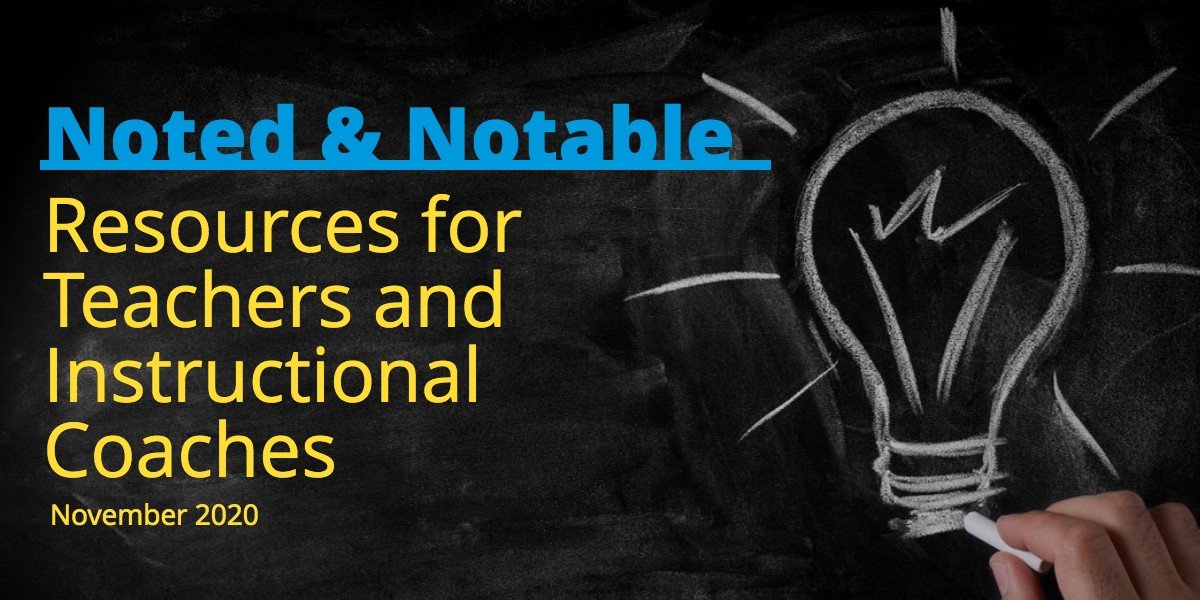Resources for Teachers & Instructional Coaches – November 2020
 Gobble up these recommended reads for teachers and instructional coaches during this holiday break. Here are a few articles for educators about professional development. This month’s recommendations include using project-based learning assignments during distance teaching, providing students virtual work-based experiences, and lessons learned from educators on how to support parents of younger remote students.
Gobble up these recommended reads for teachers and instructional coaches during this holiday break. Here are a few articles for educators about professional development. This month’s recommendations include using project-based learning assignments during distance teaching, providing students virtual work-based experiences, and lessons learned from educators on how to support parents of younger remote students.
Need some more side dishes for your classroom learning? Try project-based learning
Distance teaching provides an opportunity to use project-based learning, which ultimately encourages authentic work and creativity from your students.
I believe that project-based learning (PBL)—often a key strategy in physical classrooms—can be a critical component of rigorous online learning, and to turning frowns upside down. Authentic learning does not need to stop just because students are learning from home. In fact, the current situation gives us a great opportunity to show students why what we are teaching them matters and how authentic learning connects to real-world problems. PBL is a great way to facilitate this understanding—and it takes just a few steps to facilitate active, engaging lessons in the online setting. Driving questions are core to project-based learning, and there’s no reason why they can’t work in a virtual environment. Think of a driving question as one that gets students engaged and active. Don’t think “what,” think “how.” For example, if you’re a science teacher discussing ocean pollution, rather than asking, “What are three main elements contributing to ocean pollution?” (yawn), you could ask, “How would you solve the problem of ocean pollution?” Chances are, then you will see the brain engines start to rev with possibilities.
Read more on Edutopia: Use PBL To Boost Online Engagement
Gobble up these 5 ways to provide students with work experience during distance learning
There are still ways to support students with disabilities and ensure that they gain valuable work experience, even while learning remotely.
Students with disabilities who are nearing postsecondary transition need to figure out what they want to do with their lives after high school and have work-based learning experiences. These needs don’t change because students are learning remotely. Adults just have to be creative in how they communicate and collaborate to ensure students get the most out of virtual activities. Transition coordinators, vocational-rehabilitation counselors and others who support students at this stage also have to ensure they track their work with students on virtual activities and experiences to make sure they meet their transition goals in their IEPs. The transition coordinator should be communicating and collaborating with vocational rehabilitation and other community providers and strive to have everyone use the same platform to connect with the student that the district is using for remote learning, Stoehr says. “Be consistent as you can be.”
Read more on District Administration: 5 Ways to Give Students Virtual Work-Based Experiences
Parents will be mighty thankful if you un-stuff their schedule by providing these distance teaching tips
Balancing remote work and assisting children who are at home with distance learning is an issue many parents are grappling with across the nation. Fortunately, there are some things that educators can do to alleviate some of this stress that parents are facing at home.
Limit online meetings to no more than two per day; or limit meeting times to 30 minutes a meeting. My 3rd grader has four to five zoom meetings a day. By the 3rd meeting, he’s spent, and so are his classmates. Maybe it’s because the meetings are 45 minutes to an hour long. I’m not opposed to multiple daily meetings, but the time limit should be reasonable. Four to five meetings 45 minutes to an hour may sound good in theory, but it’s not practical. Either schedule four to five meetings for 20 to 30 minutes or have two to three (best if only two) meetings for an hour. Their screen time is already maxed; no need to exhaust them to the point of disengagement. With younger students, especially, sometimes less is more. Leave a 60 to 90 minute window open in the middle of the day open for lunch and recess. There’s no imperative to maintain a remote lunch and recess schedule similar to an in-person one built around school building logistics such as limited cafeteria seating or playground space. Students are home. Like it or not, they’re eating and snacking according to their own schedule— or that of their working parents. If a parent is working from home and takes lunch at 12:30 p.m., it makes sense for students to take it then also. It makes less sense to schedule a zoom at that time. Pre-record lessons for kindergarteners and preschoolers and limit meetings to two days a week. I get the desire to make school as normal as possible for the youngest students—to keep the experience authentic to the building. But it is not. It’s also presumptuous to not provide a laptop or chromebook to those students and then expect that they’re able to participate in scheduled Zoom meetings. A safer move is for teachers to create lessons on videos or their own YouTube page wherey parents can access lessons at their disposal (within a reasonable timespan to turn in work). This would support parents who cannot focus on remote learning for long periods of time during the day and can do so best when off the clock. This strategy also helps older students also. Zoom meetings can be used for assessing student learning from those pre-recorded lessons.
Read more on EducationNext: Hacks For Schools To Support Parents of Younger Remote Students

